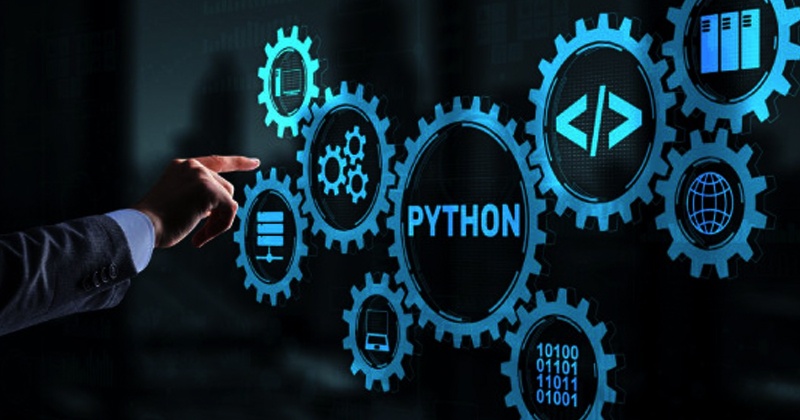
Have you noticed the buzz surrounding Python lately? It's not without reason. Python has emerged as the fastest-growing and most beloved programming language, overtaking R–– claiming the top spot in renowned popularity indices such as the TIOBE Index and the PYPL Index.
The surging interest in these domains significantly contributes to Python's escalating popularity. So, what exactly is Python? And why is Python a language of choice for data scientists?
What is Python, and Why is it Popular?
Introduced in 1991, Python is emerging as the most demanding programming language. Renowned for its readability and user-friendly design, this open-source and general-purpose language has found extensive application beyond the data science industry. Python's versatility extends to domains like web development and video game development, underscoring its broad relevance and widespread adoption across diverse fields.
So, what's the hype about Python? Well, the reasons are
- Python is an open-source, all-purpose language.
- Python is highly readable, has simple syntax, and is beginner-friendly, making it accessible for newcomers to programming and data science.
- Python is modular, smoothly blending into different technologies and solutions.
Plus, the Python Software Foundation ensures the language maintains its quality and stays on the right course. This interpreted, general-purpose programming language stands as a top choice for modern software development. Python also plays well in projects ranging from machine learning to blockchain, making it a go-to-choice for a whole spectrum of industries.
A Great Choice for Data Scientists and Data Science Projects
Although we have discussed which programming language—Python or R is ideal for Data Science, the indices of TIOBE Index and the PYPL Index show that Python shines brightly in this field. There are several compelling reasons:
-
Complete Package for Data Analysis
Python is not just a general-purpose language. Among the other programming languages, it is specifically designed for data analysis tasks. Data scientists often engage with various algorithms, and Python is well-equipped to handle the complexities of these algorithms seamlessly. -
Easy Implementation for Data Scientists
Python's charm lies in its simplicity, making it a welcoming choice for data scientists. As a beginner-friendly language, Python allows one to focus on understanding the language before delving into advanced topics like artificial intelligence or machine learning. -
Libraries and Scalability
Python offers a comprehensive collection of hundreds and thousands of libraries, including those favored by data scientists. Additionally, it boasts exclusive libraries, providing a rich ecosystem for data science tasks. The language's scalability is cherry on the top, allowing the development of robust applications with ease – crucial for crafting robust applications in the data scientist's toolkit. -
Massive Community Support
Imagine having a trusty companion on your data science journey – that's Python's robust community. When data scientists face hurdles, this collaborative community becomes a guiding light. With a wealth of shared knowledge, troubleshooting Python-related challenges becomes a breeze. -
Machine Learning Capabilities
Python flaunts its prowess in machine learning— for its standout feature, giving it a significant edge over competitors. Armed with an extensive suite of packages, Python caters to every nuance of machine learning tasks – scientific computing, statistical modeling, or delving into linear and symbolic algebra.
Use of Python Programming in the Data Science projects
Python assumes a critical role in transforming complex data into an easily interpretable spreadsheet format. Python's significance extends beyond data manipulation; in every data science project, Python is used in—
-
Data Cleaning and Preparation
Python is a staple for data-cleaning tasks due to its ease of use and robust libraries, particularly Pandas and NumPy.- Pandas facilitate reading/writing data, handling missing values, and executing transformations, streamlining the often repetitive or tedious data preparation process.
- NumPy provides support for large, multi-dimensional arrays and matrices, essential for numerical operations and efficient data handling.
-
Data Analysis and Exploration
With libraries like SciPy and NumPy, Python extends its utility beyond preparation to data analytics.- SciPy offers numerical and statistical functions, while NumPy supports working with high-dimensional arrays, making Python an excellent tool for data exploration.
-
Data Visualization
Python is highly regarded for data visualization using libraries such as matplotlib and seaborn.- Bokeh, a library for interactive visualization, is gaining popularity, highlighting Python's capacity to create sophisticated visualizations with minimal code.
-
Machine Learning
Python, a favored language for machine learning, relies on the Scikit-learn library.- Scikit-learn provides a comprehensive set of tools for building machine learning models, including preprocessing data, training models, and evaluating results.
-
Deep Learning
Python's popularity in deep learning is evident through libraries like TensorFlow and Keras.- TensorFlow and Keras, widely adopted for deep learning, offer functions for building and training models, and access to a diverse range of pre-trained models.
How do Data Science Professionals use Python Programming Across Industries?
The simplicity, readability, versatility, and flexibility of Python have made it the language of choice for data professionals spanning various industries and used in numerous job roles—
-
FinTech Industry
Python's prevalence in the financial services industry is evident in its extensive use for risk management, fraud prevention, and personalized banking. Prominent FinTech platforms such as Venmo, Affirm, and Robinhood are built on Python, showcasing their pivotal role in delivering high-quality customer service through automation. -
Transportation Industry
Major companies like Uber employ Python through the Michelangelo PyML machine learning platform. With its help, they tackle daily tasks based on online and offline predictions. Python's versatility and adaptability make it a key player in addressing the dynamic challenges of the transportation sector. -
Travel Industry
In the travel sector, online booking platforms leverage data science to identify opportunities for enhancing customer experiences. AI-driven applications like chatbots, recommender systems, and predictive analytics powered by Python, decipher meaningful insights to personalize services. A case in point is Skyscanner, which utilizes Python to predict the behavior of new flight routes. -
Healthcare Industry
The healthcare domain, dealing with vast and sensitive data, requires a language capable of handling security threats. Python stands out as a programming language that not only addresses security concerns but benefits from a vigilant community that swiftly detects and remedies vulnerabilities. The healthcare industry's reliance on Python reflects its trust in the language's robust capabilities for data analysis and protection.
The Need to Learn Python
To start your data science journey, learning Python is your compass. Choosing Python for data science is a strategic decision grounded in its undeniable advantages, contributing to its widespread acceptance and continued growth.
Python has become a reliable language for data science, and it is for good reasons--- it's adaptable, easy to understand, and comes with strong community support. Businesses find it instrumental in making smart decisions, streamlining operations, and gaining that competitive edge.
End Note
As a top-tier programming language for data science, Python offers simplicity, an extensive ecosystem, and unwavering community support. Its applicability spans a wide range of data science domains, making it not just a liked but a frequently chosen language in data science and an essential ally for data science professionals.
































